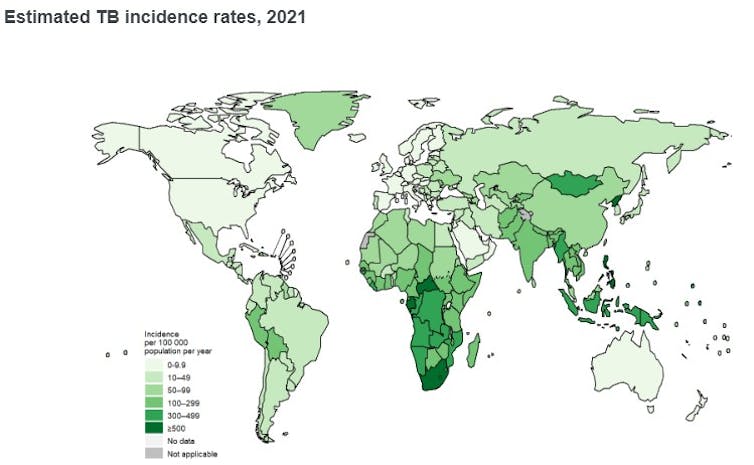TB is once again the deadliest disease in Africa - what went wrong?

Covid-19 surpassed TB as a killer over the past two years. The number of people dying from TB have been going down since 2005. But now TB is again at number one. Between 2019 and 2021 the number of people provided with treatment for TB decreased – largely due to Covid-related lockdowns. In 2021, 61% of people with TB were receiving treatment, this is lower that 69% in 2020.
What went wrong?
Progress in TB elimination was being made. But the COVID-19 pandemic and associated lockdowns have set back TB control programmes worldwide. More so in Africa. While COVID-19 prevention measures like mask-wearing could have prevented TB transmission, on the whole, little attention was given to holding the forts of TB prevention and treatment as all efforts went to fighting the Covid-19 pandemic, disrupting well-functioning programmes built over decades of careful research and planning. This disruption has resulted in the following:
a) Increased TB cases:
In 2021, there were 10.6 million new active TB cases worldwide: up from 9.9 million in 2020. These increases have been in both drug-sensitive and multi-drug-resistant TB cases.
b) Increased TB deaths:
c) Decline in TB global spending during and after Covid-19 pandemic:
Global spending on essential TB services dropped from $6.0bn in 2019 to $5.4bn in 2021. This is less than half of what is needed. The war in Ukraine has compounded this extended decline in TB prevention and control. Even before the Russian invasion, Ukraine had a high TB rate. The war has exacerbated the situation with health facilities being destroyed and people displaced. African TB control programmes that rely on aid and Global Fund support have been affected most.
How do we correct this?
The first End TB Strategy milestones for reductions in TB disease should guide what needs to be done. This includes 20% reduction in 2015 TB incidence rates, and 35% reduction in total number of TB deaths benchmarked in 2015. Three high TB burden countries in Africa have reached or passed the first milestones of the End TB Strategy for both reductions in TB incidence and TB deaths: Kenya (in 2018), Tanzania (in 2019) and Zambia (in 2021). Ethiopia is very close. However, the larger part of the African continent has seen a reversal in gains made.
Intensified efforts to obtain funding are urgently required to mitigate and reverse the negative impacts of the COVID-19 pandemic on TB. This has become even more pressing in the context of ongoing conflicts in Africa and other parts of the world, which are likely to worsen some of the broader determinants of TB such as undernutrition.
Priorities for TB care should be:
- Increase budget and human resources for existing TB and TB/HIV services
- Develop digital platforms for training and health education. Develop public-facing dashboards for TB surveillance data. Develop telemedicine with the use of digital platforms for consultation. Reduce loss to follow up
- Strengthen community-based TB treatment services
- Scale up virtual care, and community-monitoring solutions to provide remote support such as video-supported therapy. Scale up SMS-based communication to improve treatment adherence and patient-centred care and support
TB prevention should focus on:
- Target high-risk groups for universal testing, to find most or all missing active TB cases in communities
Strengthen community-based active case finding and tuberculosis diagnostic services (including in shelters for people who are homeless)
- Integrate TB, HIV and Covid-19 services including screening and testing, case finding and prevention.
- Enhance screening and case-finding activities at health facilities, including targeting high-risk groups
- Increased screening for TB in high-risk groups. Use rapid turnaround molecular tests with high sensitivity and specificity for dual diagnostic testing for TB and Covid-19
- Expand use of chest radiography with or without computer-aided detection for TB, and improve facility-based screening
- Ensure regular supply of diagnostics and drugs through local manufacturing.
This article is part of a media partnership between The Conversation Africa and the 2022 Conference on Public Health in Africa.
This article is republished from The Conversation under a Creative Commons license. Read the original article.![]()
Source: The Conversation Africa

The Conversation Africa is an independent source of news and views from the academic and research community. Its aim is to promote better understanding of current affairs and complex issues, and allow for a better quality of public discourse and conversation.
Go to: https://theconversation.com/africaAbout Tom Nyirenda
Tom Nyirenda, Extraordinary Senior Lecture in the Department of Global Health , Stellenbosch University.Related
#WorldTBDay: Minerals Council SA launches multiple language Ex-Mineworkers Occupational Lung Disease Guide 24 Mar 2025 Controversy erupts over R28m spent on NHI marketing 24 Feb 2025 #MiningIndaba: Minerals Council says Trump funding freeze won’t affect mine HIV treatment 5 Feb 2025 Virtual reality laboratory bridges the gap between psychology and technology 3 Sep 2024 Study revolutionises global TB treatment 28 Aug 2024 Intercare Group to celebrate International Nurses Day 10 May 2024
























